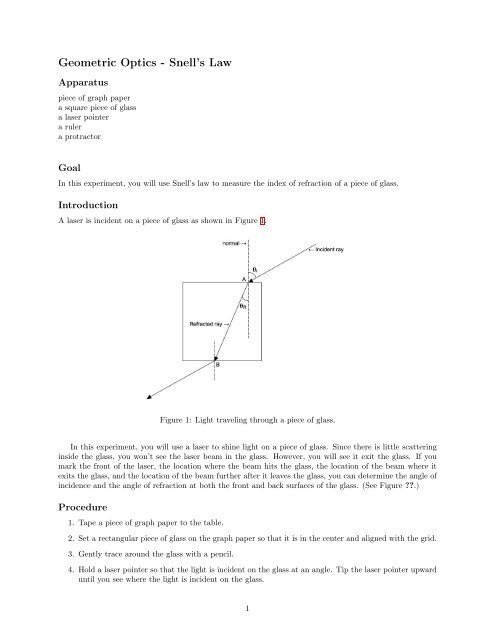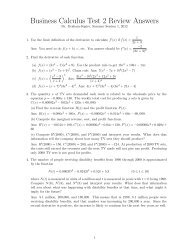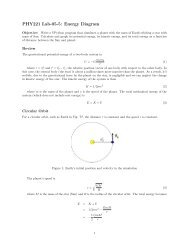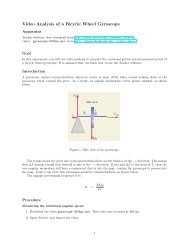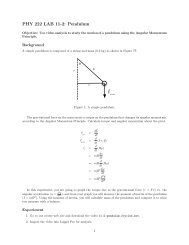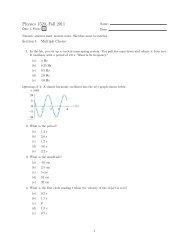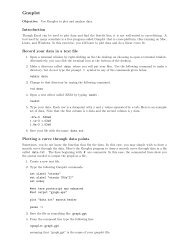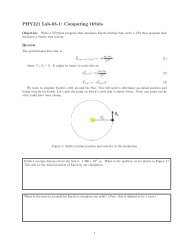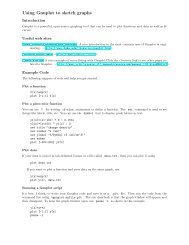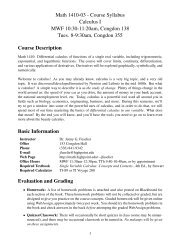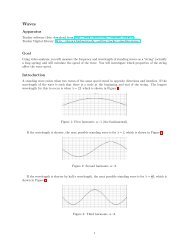Geometric Optics - Snell's Law
Geometric Optics - Snell's Law
Geometric Optics - Snell's Law
Create successful ePaper yourself
Turn your PDF publications into a flip-book with our unique Google optimized e-Paper software.
<strong>Geometric</strong> <strong>Optics</strong> - Snell’s <strong>Law</strong>Apparatuspiece of graph papera square piece of glassa laser pointera rulera protractorGoalIn this experiment, you will use Snell’s law to measure the index of refraction of a piece of glass.IntroductionA laser is incident on a piece of glass as shown in Figure 1.Figure 1: Light traveling through a piece of glass.In this experiment, you will use a laser to shine light on a piece of glass. Since there is little scatteringinside the glass, you won’t see the laser beam in the glass. However, you will see it exit the glass. If youmark the front of the laser, the location where the beam hits the glass, the location of the beam where itexits the glass, and the location of the beam further after it leaves the glass, you can determine the angle ofincidence and the angle of refraction at both the front and back surfaces of the glass. (See Figure ??.)Procedure1. Tape a piece of graph paper to the table.2. Set a rectangular piece of glass on the graph paper so that it is in the center and aligned with the grid.3. Gently trace around the glass with a pencil.4. Hold a laser pointer so that the light is incident on the glass at an angle. Tip the laser pointer upwarduntil you see where the light is incident on the glass.1
Figure 2: Marks on a piece of paper to indicate the path of the beam.5. Hold a screen on the other side of the glass near the last mark in Figure 2.6. With your pencil, make four marks at the approximately locations shown in Figure 2.7. Move your glass from the graph paper, and use your ruler to sketch a ray diagram similar to the oneshown in Figure 2. Also sketch the normals at the locations where the light enters and exits the glass.8. Use your protractor to measure the angle of incidence and angle of refraction at each boundary.9. Use Snell’s law to calculate the index of refraction using data from each boundary. (This should resultin two different calculations of n.)10. Repeat the experiment so that each member of your group makes one set of measurements on a pieceof paper, making all marks and measuring all angles on their own. Other members of the group shouldcheck their work for accuracy. Enter your data in the table below. You might end up with less than 6measurements if you have only 2 persons in your group.trial θ 1 θ 2 n glass123456Analysis1. Calculate the average and standard deviation of the index of refraction n for your five trials.2
Lab ReportName:Lab Partners:Date:Name of experiment:1. Record your data.trial θ 1 θ 2 n glass123456782. What is the index of refraction of the glass? (Report the average ± the standard deviation.)3. Attach one piece of paper to your lab report that shows the rays, the boundaries of the glass, and themeasured angles of incidence and refraction.3


